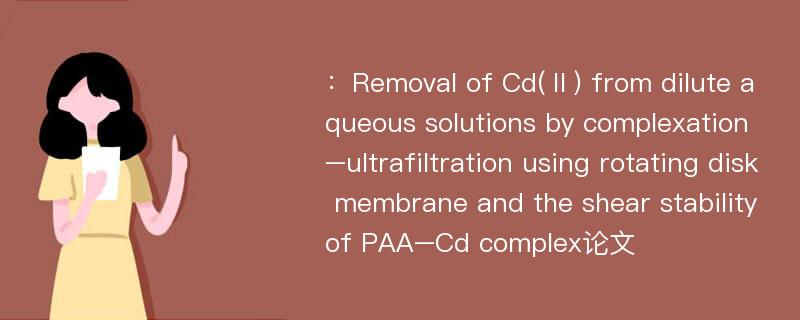
本文主要研究内容
作者(2019)在《Removal of Cd(Ⅱ) from dilute aqueous solutions by complexation–ultrafiltration using rotating disk membrane and the shear stability of PAA–Cd complex》一文中研究指出:Removal of cadmium(Ⅱ) ions from dilute aqueous solutions by complexation–ultrafiltration using rotating disk membrane was investigated. Polyacrylic acid sodium(PAAS) was used as complexation agent, as key factors of complexation, pH and the mass ratio of PAAS to Cd2+(P/M) were studied, and the optimum complexation–ultrafiltration conditions were obtained. The effects of rotating speed(n) on the stability of PAA–Cd complex was studied with two kinds of rotating disk, disk Ⅰ(without vane) and disk Ⅱ(with six rectangular vanes) at a certain range of rotating speed. Both of the rejection could reach 99.7% when n was lower than 2370 r·min-1 and 1320 r·min-1, for disk I and disk Ⅱ, respectively. However, when rotating speed exceeds a certain value,the critical rotating speed(nc), the rejection of Cd(Ⅱ) decreases greatly. The distribution of form of cadmium on the membrane was established by the membrane partition model, and the critical shear rate(γc), the smallest shear rate at which the PAA–Cd complex begins to dissociate, was calculated based on the membrane partition model and mass balance. The critical shear rates(γc) of PAA–Cd complex were 5.9 × 104s-1, 1.01 × 105s-1,and 1.31 × 105s-1 at pH = 5.0, 5.5, and 6.0, respectively. In addition, the regeneration of PAAS was achieved by shear induced dissociation and ultrafiltration.
Abstract
Removal of cadmium(Ⅱ) ions from dilute aqueous solutions by complexation–ultrafiltration using rotating disk membrane was investigated. Polyacrylic acid sodium(PAAS) was used as complexation agent, as key factors of complexation, pH and the mass ratio of PAAS to Cd2+(P/M) were studied, and the optimum complexation–ultrafiltration conditions were obtained. The effects of rotating speed(n) on the stability of PAA–Cd complex was studied with two kinds of rotating disk, disk Ⅰ(without vane) and disk Ⅱ(with six rectangular vanes) at a certain range of rotating speed. Both of the rejection could reach 99.7% when n was lower than 2370 r·min-1 and 1320 r·min-1, for disk I and disk Ⅱ, respectively. However, when rotating speed exceeds a certain value,the critical rotating speed(nc), the rejection of Cd(Ⅱ) decreases greatly. The distribution of form of cadmium on the membrane was established by the membrane partition model, and the critical shear rate(γc), the smallest shear rate at which the PAA–Cd complex begins to dissociate, was calculated based on the membrane partition model and mass balance. The critical shear rates(γc) of PAA–Cd complex were 5.9 × 104s-1, 1.01 × 105s-1,and 1.31 × 105s-1 at pH = 5.0, 5.5, and 6.0, respectively. In addition, the regeneration of PAAS was achieved by shear induced dissociation and ultrafiltration.
论文参考文献
论文详细介绍
论文作者分别是来自Chinese Journal of Chemical Engineering的,发表于刊物Chinese Journal of Chemical Engineering2019年03期论文,是一篇关于,Chinese Journal of Chemical Engineering2019年03期论文的文章。本文可供学术参考使用,各位学者可以免费参考阅读下载,文章观点不代表本站观点,资料来自Chinese Journal of Chemical Engineering2019年03期论文网站,若本站收录的文献无意侵犯了您的著作版权,请联系我们删除。
